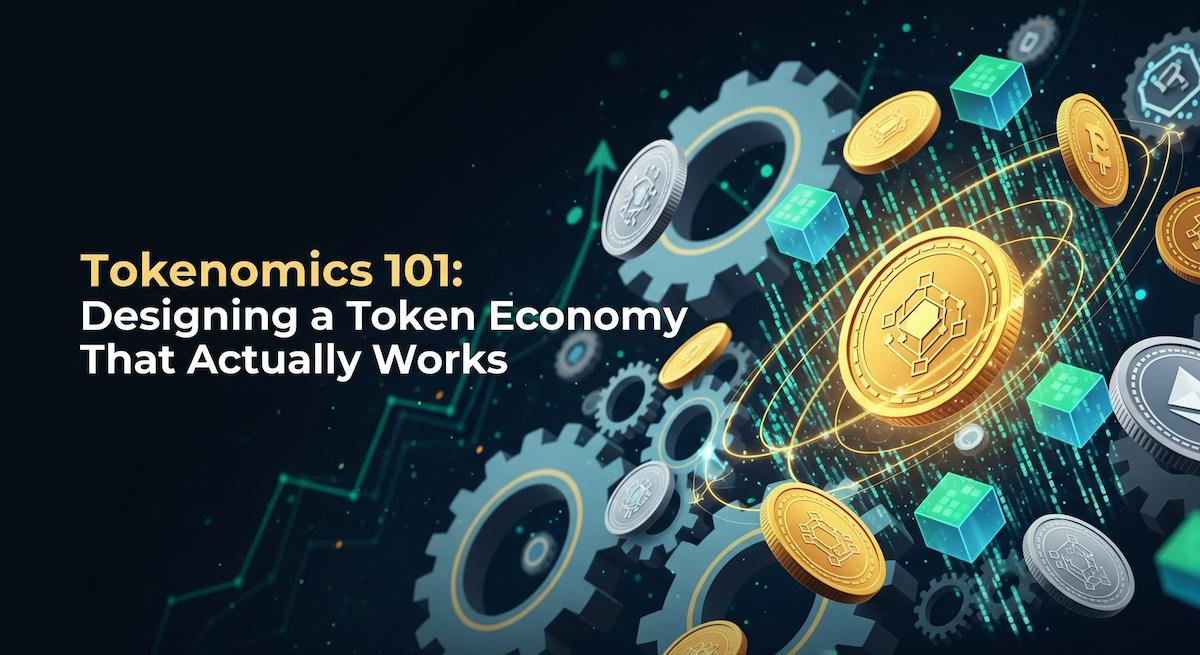In the evolving landscape of blockchain and decentralized finance, tokens are far more than digital assets. They are the lifeblood of decentralized ecosystems, driving participation, governance, and value creation. Yet, the true strength of any token lies not merely in its code, but in the tokenomics that powers it. Tokenomics, a blend of “token” and “economics,” refers to the design of a token’s economic model—the rules, incentives, and structures that determine how it functions and grows within an ecosystem. A well‑crafted token economy can be the difference between a thriving Web3 project and one that collapses into obscurity.
This guide explores the principles of effective tokenomics, examines key components of token economies, and highlights strategies for designing token models that are sustainable, appealing to investors, and capable of driving long‑term growth.
Understanding the Foundations of Tokenomics
At its core, tokenomics addresses one critical question: why should people hold, use, or invest in your token? Unlike traditional shares or commodities, tokens derive their value from a mix of utility, scarcity, and network adoption. A robust tokenomics framework ensures that a token has a clear purpose, aligns the interests of stakeholders, and creates self‑sustaining demand within the ecosystem.
Tokens typically fall into categories that define their roles within a project. Utility tokens grant access to products or services, governance tokens provide voting power in decentralized autonomous organizations (DAOs), and security tokens represent ownership in real‑world or digital assets. Understanding a token’s category is the first step in designing its economy because it determines how participants will interact with it. For example, a DeFi protocol’s governance token must encourage long‑term staking and voting participation, while an NFT marketplace token may focus on transaction fee discounts and community rewards.
A token without a clearly defined purpose or economic structure risks becoming a speculative instrument with no sustainable use case, often leading to price volatility and loss of investor confidence. Successful projects like Uniswap (UNI) and Chainlink (LINK) demonstrate how a strong tokenomics framework can anchor real demand to a token, ensuring consistent utility even amid market cycles.
Key Components of a Token Economy
Designing a functional tokenomics model requires a careful balance of multiple components, each influencing the token’s value, sustainability, and adoption.
1. Token Supply and Distribution
The supply of a token—both total and circulating—plays a central role in its valuation and market dynamics. Projects often define a maximum supply to create scarcity, similar to Bitcoin’s 21 million cap. However, the distribution strategy is equally critical. Allocating tokens across stakeholders—founders, investors, community, ecosystem funds, and public sale participants—can either foster trust or create risks of market manipulation.
For example, an overconcentration of tokens in team wallets may trigger sell‑off fears, while generous community allocations through airdrops and rewards can drive organic adoption. Successful projects often implement vesting schedules to prevent early contributors from dumping tokens, ensuring stability in the early stages of market listing.
2. Utility and Use Cases
A token with clear, compelling utility drives sustainable demand. Utility can take many forms, including transaction fees, governance participation, access to exclusive features, or staking for yield generation. A classic example is Binance Coin (BNB), which incentivizes exchange users with reduced trading fees, fuels the Binance Smart Chain ecosystem, and supports token burns that enhance its scarcity.
Utility must be designed to be intrinsic to the project’s ecosystem. A token whose primary value relies only on speculative trading rarely maintains long‑term relevance. Web3 gaming projects, for instance, create dual‑token systems—one for in‑game utility and one for governance or value capture—to prevent inflation and sustain player engagement.
3. Incentive Mechanisms
Incentives lie at the heart of tokenomics, influencing user behavior and participation. A project must determine how to reward early adopters, encourage long‑term holding, and disincentivize harmful practices such as pump‑and‑dump schemes.
Mechanisms like staking, yield farming, and liquidity mining have become staples in DeFi projects. By locking up tokens, users earn rewards while simultaneously reducing circulating supply, helping stabilize prices. However, incentives must be sustainable; unsustainably high APYs can lead to hyperinflation and eventual market crashes, as seen with several failed DeFi projects in 2021‑2022.
4. Governance and Decision‑Making
Decentralization is a cornerstone of blockchain ecosystems, and governance tokens enable the community to influence the project’s future. A strong governance model encourages token holders to actively participate in protocol decisions, creating a sense of ownership that strengthens loyalty.
The success of MakerDAO and Aave illustrates how well‑structured governance can drive protocol evolution while maintaining decentralization. Governance mechanisms can include voting on protocol upgrades, adjusting reward parameters, or deploying treasury funds. To increase engagement, projects often pair governance rights with economic incentives, rewarding active participants.
5. Inflation, Deflation, and Burn Mechanisms
The economic model of a token must carefully balance inflation and deflation. Inflationary tokens introduce new supply over time, which can incentivize participation but risks diluting value if demand does not keep pace. Deflationary mechanisms, such as periodic token burns, create scarcity and can support price appreciation.
Ethereum’s transition to a deflationary model with EIP‑1559 illustrates the market impact of well‑designed token sinks. By burning a portion of transaction fees, ETH reduces its net supply, aligning network activity with token value. Similarly, projects like PancakeSwap implement regular token burns to combat inflation from reward emissions.
Strategies for Designing a Sustainable Token Economy
Creating tokenomics that actually works requires more than simply copying successful models. Every project has unique goals, users, and growth expectations. Here are some strategies for designing sustainable token economies:
Align Utility with Core Product Value
The token’s primary function should enhance the core product or service rather than exist as a standalone speculative asset. For instance, Filecoin’s FIL token is directly tied to storage capacity and retrieval on the network, ensuring intrinsic demand for its utility.
Balance Early Incentives with Long‑Term Viability
Rewarding early adopters through airdrops, staking, or mining campaigns can accelerate adoption, but excessive rewards can lead to hyperinflation and sell pressure. Gradual reward reductions, similar to Bitcoin’s halving events, create predictable scarcity and align long‑term incentives.
Integrate Dynamic Mechanisms
Markets evolve, and so should tokenomics. Protocols can implement adjustable parameters for staking rewards, transaction fees, or burn rates to adapt to changing conditions. DAOs and governance votes can facilitate these adjustments, ensuring the token model remains resilient.
Incorporate Real‑World and Cross‑Chain Utility
As Web3 grows more interconnected, tokens that operate across multiple ecosystems gain additional value. Cross‑chain functionality or real‑world integrations, such as payment gateways or asset tokenization, can enhance a token’s relevance and mitigate reliance on a single platform.
Prioritize Transparency and Security
A token economy thrives on trust. Transparent token allocation, publicly auditable smart contracts, and regular community updates build confidence. Security audits and anti‑whale measures further protect the ecosystem from manipulation.
Real‑World Examples of Effective Tokenomics
Several projects demonstrate the power of thoughtful tokenomics in achieving long‑term growth and market resilience:
- Chainlink (LINK): The token incentivizes node operators to provide accurate data to smart contracts, creating direct utility and demand. Its capped supply and widespread integration in DeFi make it a reliable example of sustainable tokenomics.
- Axie Infinity (AXS and SLP): Initially, the dual‑token model allowed players to earn and govern the ecosystem. While early hyperinflation of SLP presented challenges, Axie’s adjustment of rewards and burn mechanisms illustrates the importance of dynamic tokenomics.
- Uniswap (UNI): By combining governance utility with liquidity incentives, UNI maintains community participation while avoiding unnecessary inflation. Its token remains a cornerstone of decentralized exchange governance.
These cases underline that successful token economies are not static; they evolve alongside user behavior, market demand, and technological progress.
The Future of Tokenomics
As blockchain technology matures, tokenomics will continue to evolve from speculative designs toward utility‑driven ecosystems. Emerging trends such as real‑world asset tokenization, on‑chain credit systems, and AI‑driven incentive modeling will create more sophisticated economic frameworks. Projects that combine strong product‑market fit with adaptive tokenomics will stand out as the market moves toward mass adoption.
In the coming years, designing a token economy that “actually works” will require an interdisciplinary approach, blending economics, behavioral incentives, governance theory, and blockchain engineering. Tokenomics is no longer a side consideration—it is the blueprint that determines whether a token becomes a thriving digital economy or a forgotten experiment.



